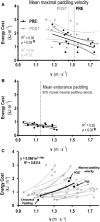The impact of a single surfing paddling cycle on fatigue and energy cost
- PMID: 33633202
- PMCID: PMC7907393
- DOI: 10.1038/s41598-021-83900-y
The impact of a single surfing paddling cycle on fatigue and energy cost
Abstract
Surfing is one additional sport proposed by the Tokyo 2020 Organizing Committee. Surprisingly, substantial efforts to understand surfing energetics are recent, and the impact of a single surfing paddling cycle on fatigue and energy cost is still not clear. Since surfing paddling technique is highly specific, experiments in real practice conditions are necessary to provide deeper insights. Through a biophysical approach, biomechanical and energetics responses of surfing paddling were quantified and compared from 16 competitive male surfers (23.5 ± 10.0 years old, 65.3 ± 11.4 kg and 1.72 ± 0.01 m) during two sets (PRE and POST) of 10 s all-out tethered paddling plus 20 m sprint paddling, interposed by 6 min of endurance paddling. Faster surfers presented lower energy cost during sprint PRE (r2 = 0.30, p = 0.03) and endurance (r2 = 0.35, p = 0.02) relative surfing paddling velocities. Although the energy cost was higher for a lower velocity at maximal paddling velocity POST, the energy cost of surfing paddling increased with absolute velocity according to a power function (R2 = 0.83). Our results suggest that fatigue seems to occur even following a single surfing paddling cycle. Developing a powerful and endurable metabolic base while reducing energy cost during surfing paddling should be seen as key factors in surfing training programs.
Conflict of interest statement
The authors declare no competing interests.
Figures







Similar articles
-
Anaerobic Energy Production During Sprint Paddling in Junior Competitive and Recreational Surfers.Int J Sports Physiol Perform. 2016 Sep;11(6):810-815. doi: 10.1123/ijspp.2015-0558. Epub 2016 Aug 24. Int J Sports Physiol Perform. 2016. PMID: 26694539
-
Maximal Strength Training Improves Surfboard Sprint and Endurance Paddling Performance in Competitive and Recreational Surfers.J Strength Cond Res. 2017 Jan;31(1):244-253. doi: 10.1519/JSC.0000000000001483. J Strength Cond Res. 2017. PMID: 27253832 Clinical Trial.
-
Reductions in Sprint Paddling Ability and Countermovement Jump Performance After Surfing Training.J Strength Cond Res. 2015 Jul;29(7):1937-42. doi: 10.1519/JSC.0000000000000843. J Strength Cond Res. 2015. PMID: 25559904
-
Physiological aspects of surfboard riding performance.Sports Med. 2005;35(1):55-70. doi: 10.2165/00007256-200535010-00005. Sports Med. 2005. PMID: 15651913 Review.
-
Performance Analysis of Surfing: A Review.J Strength Cond Res. 2017 Jan;31(1):260-271. doi: 10.1519/JSC.0000000000001442. J Strength Cond Res. 2017. PMID: 27050247 Review.
Cited by
-
The effects of a land-based warm-up and accompanying passive heat retention on core body temperature, hormones, and subsequent performance in elite surfers.Front Sports Act Living. 2024 Oct 10;6:1458268. doi: 10.3389/fspor.2024.1458268. eCollection 2024. Front Sports Act Living. 2024. PMID: 39450117 Free PMC article.
-
A Mixed Methods Exploration of Surf Therapy Piloted for Youth Well-Being in Post-Conflict Sierra Leone.Int J Environ Res Public Health. 2021 Jun 10;18(12):6267. doi: 10.3390/ijerph18126267. Int J Environ Res Public Health. 2021. PMID: 34200523 Free PMC article.
-
SHOULDER INJURY IN SURFING: A SYSTEMATIC REVIEW WITH META-ANALYSIS.Acta Ortop Bras. 2024 Oct 28;32(5):e279152. doi: 10.1590/1413-785220243205e279152. eCollection 2024. Acta Ortop Bras. 2024. PMID: 39493966 Free PMC article.
References
-
- Frank M, Zhou S, Bezerra P, Crowley Z. Effects of long-term recreational surfing on control of force and posture in older surfers: a preliminary investigation. J. Exerc. Sci. Fit. 2009;7(1):31–38. doi: 10.1016/S1728-869X(09)60005-8. - DOI
-
- Tran TT, Lundgren L, Secomb J, Farley OR, Haff GG, Seitz LB, Newton RU, Nimphius S, Sheppard JM. Comparison of physical capacities between nonselected and selected elite male competitive surfers for the National Junior Team. Int. J. Sports Physiol. Perform. 2015;10(2):178–182. doi: 10.1123/ijspp.2014-0222. - DOI - PubMed
-
- Godoy, D. F., Cadore, E. L., Feitosa, W. G., Correia, R. D. A., Castro, F. A. D. S. Oxygen uptake of wave surfers and complementary parameters in front crawl and surfing-paddling tests. J. Strength Cond. Res. 10.1519/jsc.0000000000003205 (2019). - PubMed
Publication types
MeSH terms
Substances
LinkOut - more resources
Full Text Sources
Other Literature Sources
Medical

